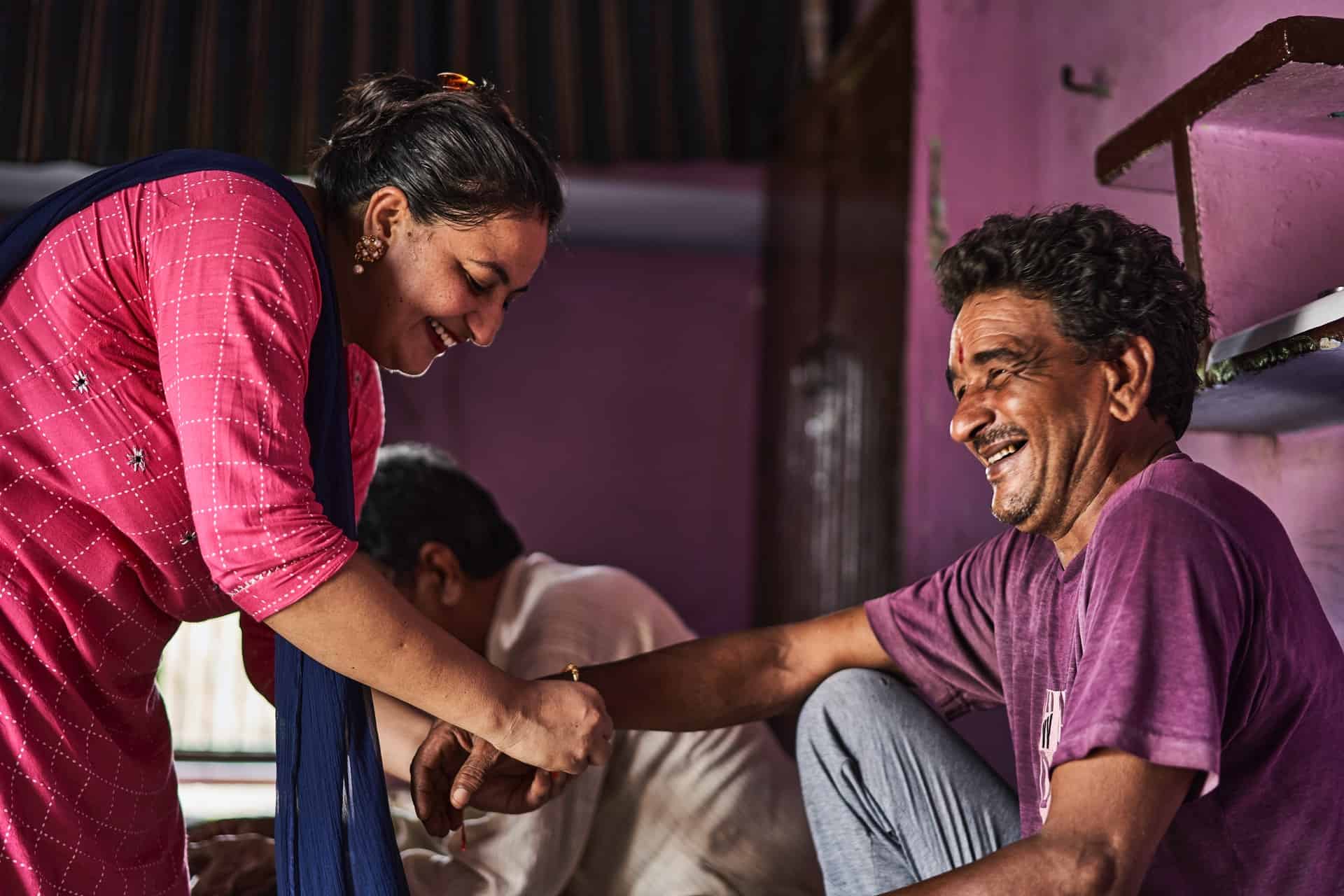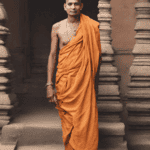Hinduism is the ancient religion being in practice many years ago. So many rituals and customs are practicing even today for various reasons.
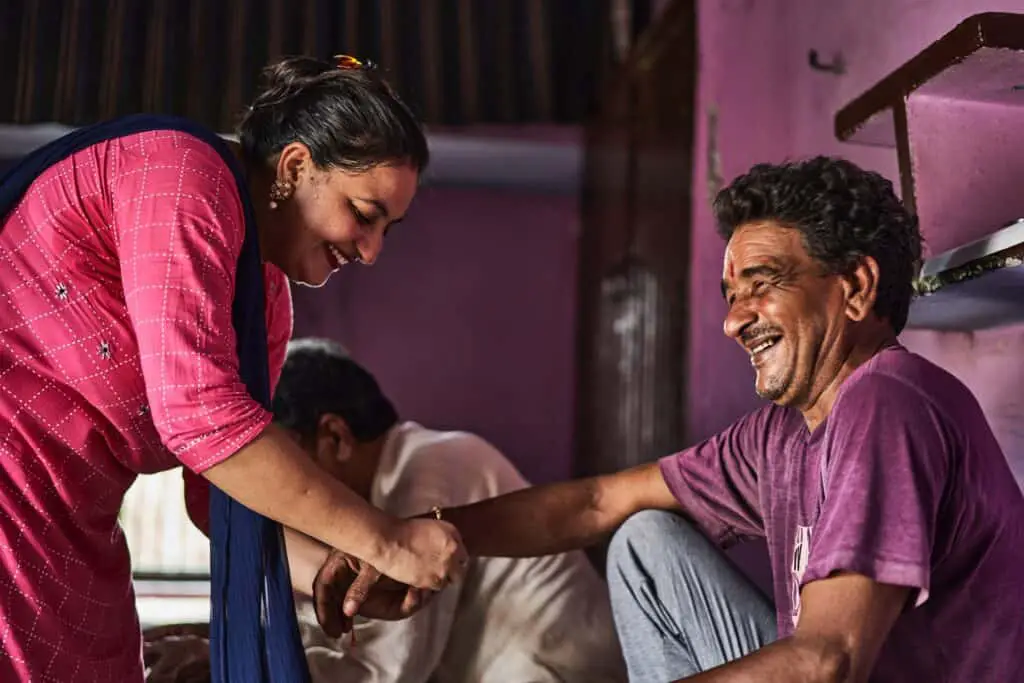
The piece of thread varying in colors is worn on various parts of the body and believed in getting ensured power and fencing from evil practices. Both men and women wear different colored threads for various but interesting reasons. The colors of the threads that are worn include white strands, black thread, red-colored thread, yellow rope or thread, etc.
Significance of threads and importance to wear it are explained in detail in Vedic scripts. Wearing various colored threads by men and women owes its necessity. The article is more likely to explain all the types of threads wear in Hinduism including the importance of wearing.
If you are interested in checking out the best threads, you can find them by clicking here.
Medieval times in India, Hindus belonging to all four groups are supposed to wear sacred threads. They are taught about the importance of wearing sacred threads. Every thread carries its necessity and importance. Elders from Hindu houses insist their children tie the thread also how long the thread gets worn in the body.
Janeu/Upanayana for Brahmins
Definition
The three strands of white-colored sacred thread are worn on the left shoulder and upon the waist to the males of Brahmins. This ceremony is called ‘’Upanayana’’ and it is held at the age of 7, 9, or 11 of the boy. The ceremony was carried in the presence of a master or Guru that accepts the individual for the start of learning.
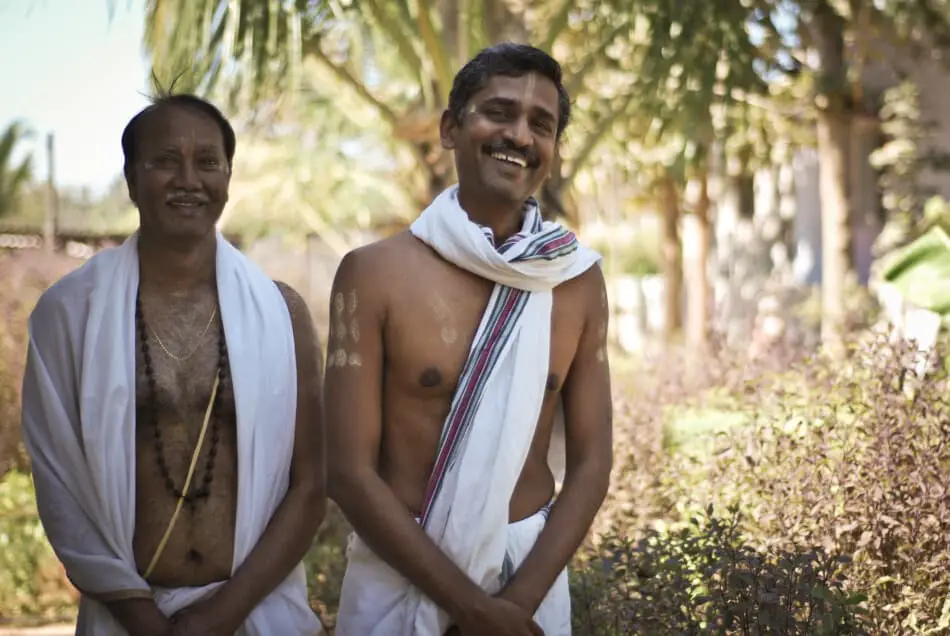
Significance
The ceremony is held necessarily and particularly in the forwarded class like Brahmins. It is identified as the beginning of the learning process all about the Vedas. Ancient Hindus underwent Upanayana in three out of four varnas (Classes) of people. In modern times, Brahmins are subjected to carry out the process in the form of ceremony.
Restrictions to wear Janeu
As mentioned above, Brahmins are eligible to conduct Upanayana and to wear the white sacred thread. The thread is the identity of an individual that is educated and eligible as a well-versed person to learn the mythological ideologies of Hinduism. The sacred thread is necessary to exchange every year and an auspicious day is meant for the process of changing new white thread by removing the older one.
Brahmins must wear the spiritual or sacred thread around their shoulder throughout their lifetime. In all good and bad events, they ought to wear the sacred thread.
Molatadu/Red thread for boys and men
Definition
This is the traditional practice being followed even today in all Hindu houses. Molatadu is the thread that is not sacred as the upanayana thread but considered as the sign of protection. Hindus from Tamil Nadu named the thread as Araignan kayiru that is believed tied around the waist of boys and men.
Hindus use black and red-colored threads either cases to tie around the waist. Metals like silver or gold are also used as Molatadu threads by Hindus from Tamil Nadu. Not exactly boys alone used to tie the Molatadu but also female babies intend to wear the thread until they attain puberty.
Significance
Hindus believed tying the thread around the waist is the symbol of protection. Most probably the thread is used to hold the victim that caught in the flood and to rescue him. For in the case of little children, the thread is tied with additional chanted lockets that are empowered mythological ethics.
Wearing ceremony
On the thirtieth day of every newborn baby, the occurrence of tying the thread is held. Hindus follow the custom and keep on wearing the thread throughout their lives. But the girls stop wearing the thread once they attain puberty rather they are encouraged to wear the thread till then.
Restrictions
Women are restricted from tied with thread and there is no certain explanation omitting women from wearing the thread around their waist.
Significance
The red or black thread wearing around waist gains much significance including the protection of the infant against evil eyes. The unique importance of red and black colored threads gained the attention of Hindus from South India to wear it. While equal importance of metals like gold and silver threads scored that much importance among the Hindus of the same criteria.
The red or black colored threads owe to protect the child from evil against the infant. However, metal like silver or gold threads induces the health aspects of the individuals. The silver thread acts as positive ions to induce immunity, health metabolism, etc While the gold thread serves to be non-toxic and tolerated by the body. It is good to wear gold on the body enhancing good metabolism and bodily functions.
Black beads for baby wrists
This is another most popular tradition that is followed in Hindu homes wear for their babies. Very often Hindu parents use to tie black colored threads connected with the same colored beads on the wrists of their babies.
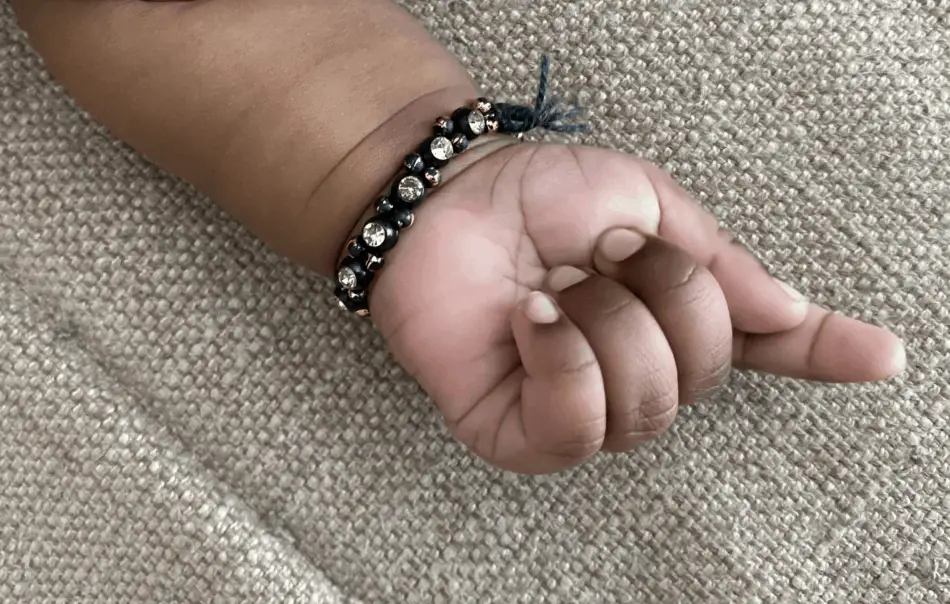
Definition
The utility of the black colored beaded threads are used to ward off their kids from evil attention. No big ceremony is observed to tie the black colored threads however Hindu parents keep continuing wearing the thread on wrists of babies.
Significance
The ultimate use of this type of thread is based on spiritual and mythological importance. But there is no scientific preference in wearing these types of threads. Alternately, the kid may suck the thread often that may lead to unhygienic habits. Moreover, the thread may get too tight when the baby puts on weight or after bathe.
Restriction
Phenomenally, there is no importance of wearing black thread rather kids because Hindus wear the thread, especially for kids or infants.
Marriage related threads
Mangalasutra/ Thaali for women
Definition
The ultimate divine and a sacred yellow rope in southern parts of India whereas the black colored beaded chain in Northern India is called Thaali in Tamil Nadu or Mangala sutra in other states of India, respectively.
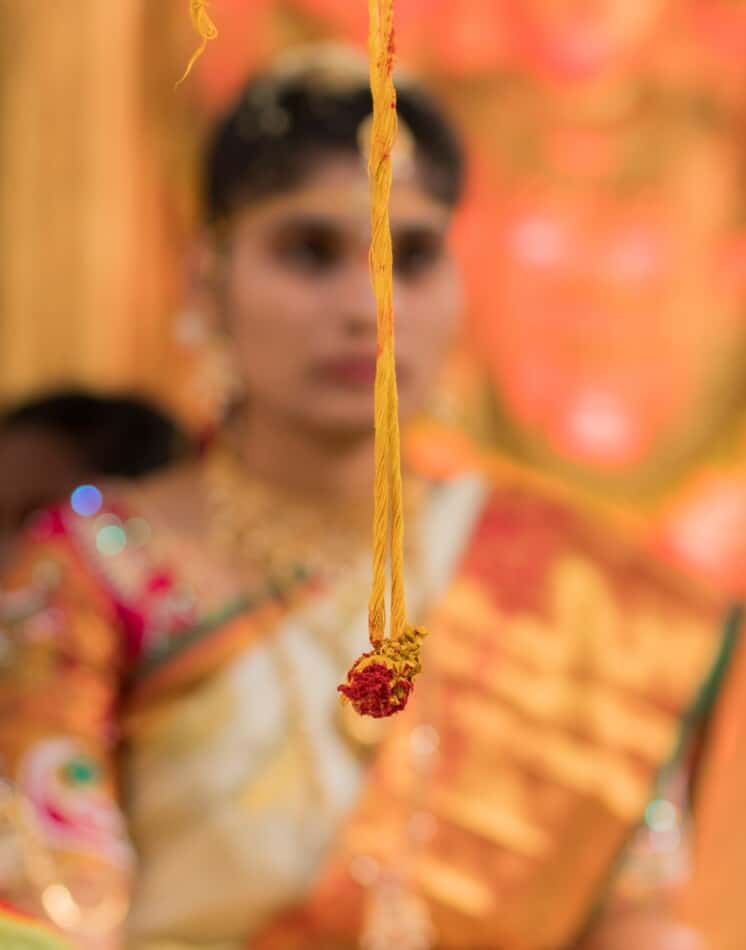
Significance
This is the identity of the married women hence female folks used to wear Thaali or Mangala sutra. Hindus believe in the mythological significance of wearing Thaali apart from social identity. Besides the scientific significance added values regarding Thaali. Coming to South India, The identification of Thaali varies among the differentiation of castes. Particularly in Tamil Nadu, Every caste has its design and symbol of Thaali.
Wearing ceremony
Ultimately, marriage is the exact occasion of wearing Thaali or Mangala sutra. The bridegroom is the one who ties the sacred yellow rope or the black colored chain around the neck of the bride. None other than bridegroom is supposed to tie the knot and bride alone should owe the sacred thread. Followed by auspicious occasion of tying the knot is the re-connection of Thaali to the golden chain from the yellow rope.
Restriction
There is no chance of removing the Thaali or Mangala sutra unnecessarily. Only the death of the male consort will allow the female to remove the Thaali.
Janeu/ Janjemu for men
Definition
The holy sacred thread worn three in numbers especially for men or boys is the Janeu or the Janjemu. The term is coined as Upanayana and occurred in the childhood stage of boys.
Significance
Beyond the spiritual and traditional reasons, more scientific importance is hidden and proved to be real in wearing the sacred thread.
Usually, three numbered threads are tied together around the left shoulder and waist as the identity of the celibate whereas six numbered threads are tied together as a sacred thread to identify the married man. Hermits and sages wore 8 strands of threads tied together.
Restrictions
There are no restrictions in wearing the sacred threads by all people of four varnas. However, Brahmins wear the sacred thread nowadays. Respected Guru or the father of boy undergoing Upanayana is supposed to wear the thread. Brahmobadesham, literally meaning the lecture of actual life and divine is conducted to the boy at the time of Upanayana.
Black thread around leg/bicep/wrist:
Hinduism prohibits the use of black colored objects in all means. According to Hinduism black color is the symbol of pessimistic ideologies however tying black colored threads in specified body parts is encouraged in Hinduism.

Definition
Black threads are tied around the specific spots in our body. The main purpose of these threads is to omit the negative vibes or the evil attention towards us. As per astrological views, black colored objects ward off the attention or evil vibes.
Wearing the threads
To wear the black colored thread, it is necessary to make eight signified knots. And at the same time, no specialized persons required to wear it but auspicious time muhurat is must to wear the thread.
Significance of threads
To achieve the best vibration of threads, it is important energizing the same by chanting mantras by the appropriate personality. Reciting Gayathri Mantra particular to Rudra is advisable while wearing the black thread.
Restriction of wearing threads
Too many restrictions prevent wearing black threads. Simply saying, it is not easy to just pick and tie on the legs or ankles or anywhere on the body. Wearing black threads on the hand along with some other sacred thread is prohibited. Other days rather Saturday is considered as an inauspicious day to wear black thread. Since Lord Shani is representative of Black color chanting mantras of Shani is necessary. Do not dare to avoid Shani chants on Saturday.
Orange/ saffron/ Red thread to hand
Definition
The color orange or saffron indicated the holy or sacred condition. The threads dyed with orange or saffron color are tied mainly for a hermitage. Sages and saints used to wear saffron threads as the sign or symbol of the hermitage.
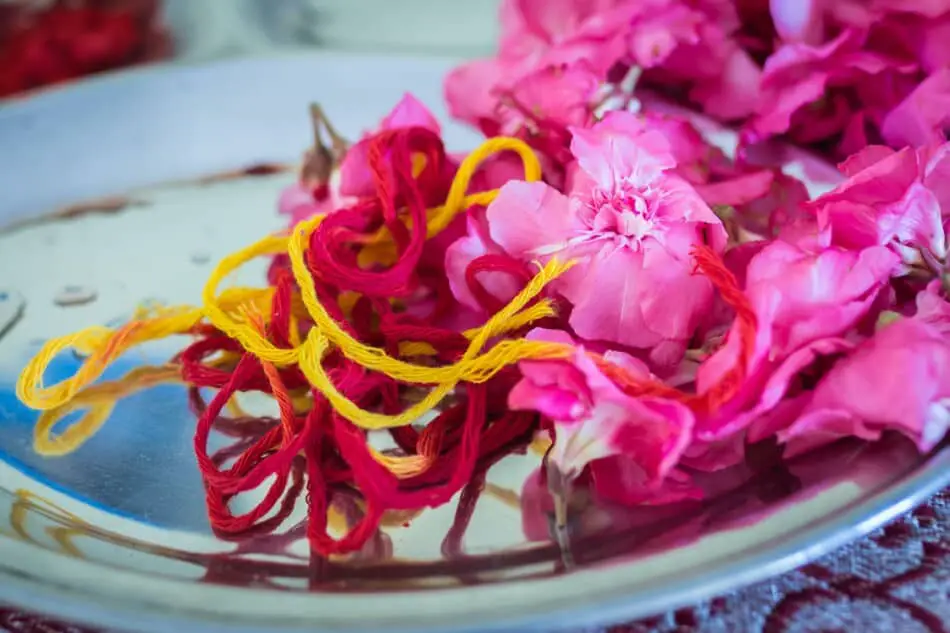
Significance
Orange or saffron-colored threads are worn as a symbol of divine and spiritual motivation. Proper chanting of slogans and mantras are insisted while wearing the spiritual threads. Hinduism follows various traditions and customs that are proven true scientifically but criticized as the superstitious, same time. Though controversial ideologies interfere, one good cause to feel the divine and superpower is using spirituality and related holy practices. Tying sacred threads is the symbol of gaining spiritual power.
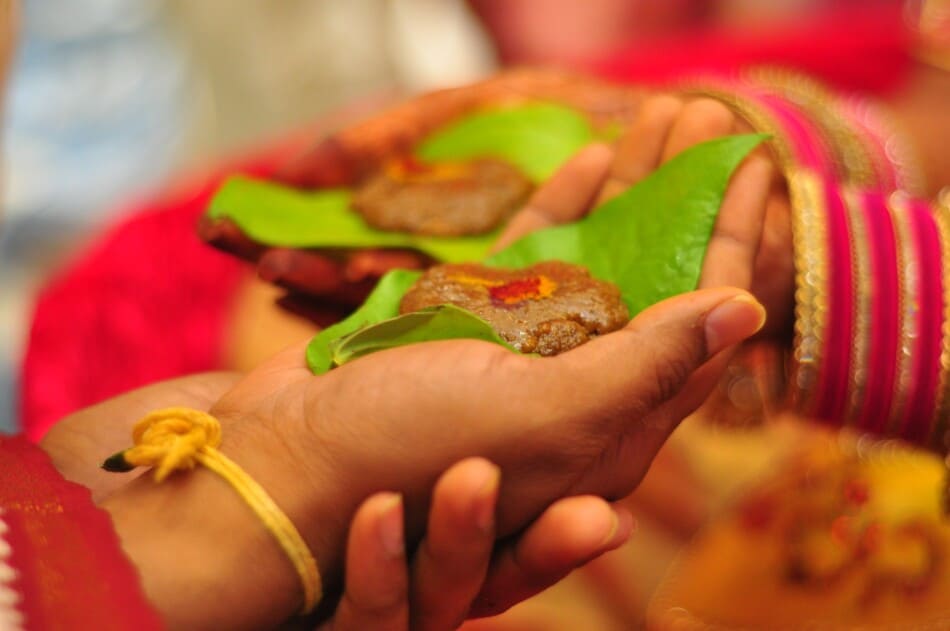
Restrictions
Wearing the sacred orange or red or saffron-colored threads does not apply to all. Only sages, saints, and monks are eligible to get tied to the sacred threads. Auspicious time and day are followed while wearing these sacred threads.
Moli in puja or prayer
Definition
Moli is also known as the Mauli or Mouli or Kalava or some other regional names familiar to tradition. The sacred or holy thread is tied in for various reasons of traditions.
Significance
The holy thread is tied as a knot on the wrist of the right hand to the males and the left hand to the females. Despite the scientific influence of tying the thread, the wearing purpose is innumerable that brings prospect and prosperity.
During the ceremony of the wedding and its related rituals, the Moli is tied as a knot by the holy priest conducting marriage to the hands of the groom. The groom in turn will tie the same sacred thread to the left hand of Bride as one among the rituals.
Similar other occasions, instance, include the tying of a red-yellow colored thread on the wrist of brother by his sister. The occasion is Raksha Bandhan and is being observed even today to develop a mutual relationship and bonding among the two.
Restrictions
Suitable restrictions are list out to tie the Moli thread in other days rather auspicious. The thread is worn after the completion of pooja rituals in any ceremony or marriage customs.
Red string bracelet
Definition
The red-colored string is worn as a bracelet in the left hand. Most probably the left hand is chosen as the choice of tying because the left hand is close to heart.
Significance
The tying of the red string bracelet brings the feel of protection, faith, strength, and a positive attitude by all means. Most of the Hindu traditions recommend tying the sacred threads in any form.
Restrictions
The order of wearing the red string bracelet is restricted for both men and women. The married women wear the red string bracelet on her left hand that is contradictory to the unmarried women that wore on the right. Hinduism preaches too many restrictions and relaxations in wearing threads accompanied by their spiritual utility. While the men can wear the red string thread on his left hand nowadays the red string bracelet is tied and being practice in other religions excluding Hinduism.
Below are some general questions related to various threads in Hinduism
What do the three strands of sacred thread or Janeu represent?
The three strands of white-colored threads are issued to the boy or the man is called the Janeu. The ceremony is conducted before the commencement of the marriage. The groom supposes to undergo a few customs and traditions while in the Janeu occurrence. Usually, three strands are given that representing the three different vows that the grooms have to take and never forget in his lifetime.
- The first vow is the due respect to the knowledge.
- The second one is the respect to the parents.
- Fine last vow is respect towards society.
Also, it is accepted that the three strands are symbolically representing the Goddess Parvathi, Lakshmi, and Saraswati individually.
Which leg is a black thread for gents?
Wearing the black thread gains more importance for both genders of male and female. An astrologer insists on customized schedules in wearing the black thread. Besides, astrological aspects, the youth community started believing all these superstitious thoughts nowadays.
Phenomenally, wearing black threads on the right legs found to be more auspicious for men and boys. Psychologically and practically speaking, the black thread worn in the right leg is proven to be beneficial. Numerous health issues and astrological insecurities are cleared off with this tying practice.
Which leg should girls wear black thread?
While concerning girls, to wear the black thread the left leg is found more auspicious. Just like tying around the left wrist, the left ankles are advisable to tie around the black threads for in the case of girls. Youngsters are much concerned about spiritual thoughts and ideologies. Also, an increased number of optimistic individuals is started focusing on mythological ethics though considered superstitious.
Even today, young people are witnessed stating that positive vibration created after tying the black thread around the left ankles. Not the astrological point of view perhaps the physical health issues are wind up with this practice of tying the black thread.
Can we remove Mangala sutra?
Mangala Sutra is the sacred rope of chain that is tied around the neck of the bride especially by her groom on the marriage ceremony. According to Indian tradition and customs, Mangala sutra is a more auspicious and respectable thread. Women respect the thread much equal to the lives of their husbands.
Lots of restrictions are followed in exchanging the old yellow rope or the chain of Mangala sutra but ultimately no good chance of removing the same is allowed in Hinduism. The woman is not allowed to remove the Mangala sutra unnecessarily without valued reason.
What are the benefits of wearing black threads on the wrist?
Significant benefits are listed out wearing black threads on the wrist. Hinduism does not accept wearing black colored cloth or objects on the body. However, black colored threads are specially chanted with mantras to ward off evil sources and powers.
Many valuable points appreciate wearing black threads on wrists but suitable restrictions are yet to follow while tying the threads. Newborn infants, young and grown individuals, and also the older people are found wearing the black threads on their wrists. Beyond the mythological importance, the black threads worn on wrists bring the developed physical and mental health.
What is a Moli or Kalava?
The holy sacred thread that appears in a combination of red-yellow is called Moli or Mauli or Mouli or Katuka or kalawa, else other names. All over India, there is a variety of names and traditions followed in wearing the sacred thread.
The holy thread is worn by the priest or guru that conducts the marriage ceremony to the hands of the groom. The later will in turn tie the thread to the hands of the bride of the marriage ceremony. The thread is known as Kaappu in Tamil Nadu. Proper rituals are held the next of marriage to remove the threat from the hands of the bride and groom.
What happens when a red string falls off?
Unless it falls off randomly, it is said to wear on the wrist. The red string falls of only when all the negative vibration is absorbed and deflected or deviated back. The individual can remove the string unless they owe to remove for a valuable reason rather he or she warns to wear the string or bracelet.
It is not advised to wear and remove the string or bracelet frequently well on convenience rather it not prohibited from random fall of.
How many beads are there in Mangala sutra? And what is their order?
Generally, the Mangala Sutra consists of nine black beads and nine golden beads alternatively. There occur two strands of seven-part black beads to complete the Mangala sutra. The black beads are mostly made of jet or glass or onyx, etc. The beads show varying colors of green, dark blue, or turn to deep pink when light is passed through them.
For in the case of Thaali in South India, there are accurately 108 fine cotton threads twisted and woven together to make a final thread that is dyed to yellow color with turmeric. People from Tamil Nadu connect the gold Thaali to the yellow rope that is worn by the groom to the bride.
Why did Shri Ram wear sacred thread while being Non-Brahmin?
As said before, Hindus of the ancient period are suggested to wear sacred thread despite their varnas they belong to. According to Vedic scripts, three out of four groups (Brahmins, Kshatriyas, and Vaisya) are known to wear the sacred threads.
The unique age limit is allotted to the boys from either class of categories. Based on these criteria, Kshatriya Shri Ram gains the credit of wearing the sacred thread.
Why does not Hinduism allow women to wear sacred threads?
Sacred threads are many in category and ideologies. The white sacred thread, Janeu, is meant especially for men but not for women. This criterion is followed as women have the eligibility for wearing various holy threads for various reasons. Ancient, medieval, and modern Hinduism does not allow women wearing the white-colored sacred threads, anymore.
